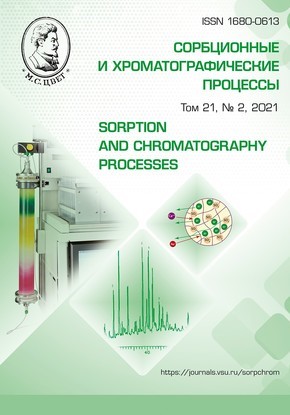Biohydroxyapatite is a new phase for the selective microweighing of organic compound vapours – markers of inflammation in the nasal mucus of calves and hu-mans Report 1. Sorption in model systems
Abstract
Abstract: In the first part of this article on the use of the nanostructured phase of biohydroxyapatite (HA), the features of the sorption of vapours of individual volatile organic compounds of various classes on the phases of biohydroxyapatite deposited on the electrodes of piezoquartz resonators of bulk acoustic waves are considered. The peculiarity of the study is the use of sorption phases of small weights (from 1 to 7 μg) and direct weighing of vapours of substances with piezoelectric balances with a sensitivity of up to 10-9 d. The dependence of the efficiency of sorption of HA to vapours of the selected compounds (alcohols, ketones, acids, arenes, amines) on the mass of the applied phase on a limited surface area of the electrodes of the piezoresonators has been established. The influence of the method for introducing sorbent vapours into the sorbent zone (vapour injection, frontal supply) has been studied. Calculations of the sorption isotherms of compounds, allowing to develop practical solutions either for highly selective detection of them in a mixture, or for assessing changes in the concentration of individual components, are presented. The features of the sorption of organic compounds vapours over a wide range of concentrations have been established. It was found that, depending on the mass of the sorbent in the studied range, vapour sorption varies from linear monolayer to multilayer. The selectivity and sensitivity of sensors with HA phases of different weights were calculated. It has been shown that some compounds can be quantitatively determined in a vapour mixture by signals from sensors with HA. Piezosensors of mass-sensitive type with HA phase of different masses are recommended as measuring elements for gas analysers and systems for the integral assessment of the composition of complex mixtures of compounds of low concentrations according to the "electronic nose" methodology.
Downloads
References
Kornev A.S., Rossijskij khimicheskij zhurnal, 2011, Vol. 112, No 6, pp. 94-101.
Rajneesh M., BARC Newslett, 2009, No 297, pp. 240-245.
Kai S., Haiqing W., Ping L., Zhigang F., Chin. J. Chem. Eng., 2008, No 4, pp. 584-589.
Ionescu R., Llobet E., Reyes L., Smulko J., Phys. status solidi B, 2008, No 11., pp. 4331-4335.
Smith N., Hong Z., Asher S., Analyst, 2014, No 24, pp. 6379-6386.
Shhedrin A.V., Sprav. inzh., 2013, No 5, pp. 51-72.
Slepneva M.A., Diss. kand. tekhn. nauk., M., 2010, 215 p.
Umarhanov R.U., Diss. kand. khim. nauk, Voronezh, 2013, 233 p.
Guozhen F., Guiyang L., Yukun Y., Shuo W., Sensоrs and Actuators. B, 2016, 230, pp. 272-280.
Vershinin N.N., Alejnikov N.N., Efimov O.N., Gusev A.L., Mezhdunarodnyj nauchnyj zhurnal al'ternativnajaj energetika i jekologija, 2009, pp. 10-15.
Bulanov E.N., Poluchenie i issledo-vanie nanostrukturirovannyh biosovmes-timyh materialov na osnove gidroksiapatita, Nizhnij Novgorod, 2012, 103 p.
Korenman Ya.I., Silina Yu.E., Kuchmenko T.A., Patent RF, No 2259007, 2004.
Kuchmenko T.A., Umarhanov R.U., Patent RF, No 2259007, 2012.
Kuchmenko T.A., Umarhanov R.U., Zhurnal analiticheskoj khimii, 2013, Vol. 68, No 4, pp. 397-405.
Kuchmenko T.A., Umarhanov R.U., Kochetova Zh.Yu., Bel'skih N.V., Zhurnal analiticheskoj khimii, 2012, Vol. 67, No 11, pp. 1032-1039.







